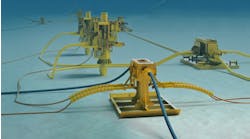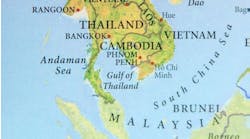Richard D’Souza
Granherne Consultant
Since 2005 the upstream industry has been stepping out into increasingly deeper, more remote frontier areas to find large reservoirs and doing so with considerable success. However, subsurface uncertainties related to ultimate recovery and long-term reservoir management have increased substantially. At todays’ low oil prices and high capital investments required for deepwater developments, operators have low tolerance for sanctioning underperforming projects. This combination of events has resulted in a dramatic plunge in the number of greenfield projects sanctioned since 2014 (three in the Gulf of Mexico). Operators are increasingly emphasizing de-risking subsurface uncertainty during appraisal before advancing a project from feasibility to development.
The primary objective of an appraisal strategy is to determine the in-place hydrocarbon volume of the discovery. The physical extent of the reservoir, whether aerially extensive or vertically stacked, drives where and how many appraisal wells are needed. The goal is to narrow the ratio of the P10 and P90 predictions to less than two. Logging and drillstem testing appraisal wells provides useful static information. In mature basins, good estimates of expected well rates and recoveries can be made from analog reservoir experience. In frontier deepwater areas, accurately predicting these parameters is significantly more challenging. In such cases, well testing is the surest way to increase confidence in predicting dynamic flow behavior and recovery factor without which the risk of sanctioning an underperforming development is unacceptably high.
Extended well testing (EWT) is an appraisal technique that requires flowing one or two wells for durations ranging from several days to several months. Test durations are governed by reservoir rock and fluid compressibility. In high permeability reservoirs durations more than 120 days are needed to determine well drainage. It is much shorter in low permeability rocks where pressure response is faster. EWTs can be designed to assess lateral and vertical reservoir communication, test efficiency of horizontal wells, completions and performance of downhole pumps in deep or heavy oil reservoirs. In short, an EWT enables significant de-risking of subsurface uncertainties, greater confidence in estimating well rate and recovery predictions, and selecting an optimized field development plan.
A major hurdle in opting to conduct a deepwater EWT has been the spread cost required to acquire this information and the delay in sanctioning the development versus proceeding with what could be a sub-optimal development with imperfect subsurface information. Operators perform a value of information (VOI) exercise to justify an EWT (or an early production system). A VOI exercise computes the NPV differential of a development that incorporates EWT information versus a development that does not. This exercise relies on the reliability of interpretation of the subsurface teams’ view of recovery with and without EWT information. In general, the longer the EWT duration the greater the confidence in interpreting development well recovery.
An EWT spread consists of a floating production platform with associated station-keeping and riser/subsea system producing from one or two wells. Well test processing capacities range from 20,000 to 50,000 b/d of oil with associated gas flared or injected. Produced oil is shuttled, generating revenue to offset cost. Other attributes of a EWT is that the platform be leased with a short contract to first oil cycle time and the ability to rapidly redeploy to multiple sites. EWTs have been extensively used in the North Sea and Brazil and to a lesser extent in West Africa, Asia/Pacific, and the GoM.
EWTs have been employed in the North Sea since 1975, primarily to reduce subsurface uncertainties in small, complex shallow water reservoirs. They were initially converted early generation semisubmersible drilling units requiring an FSO for buffer storage. ThePetrojarl 1, a thruster assisted internal turret FPSO, was deployed on 13 locations for durations ranging from three to 20 months over 28 years. Later, large (Berge Hugin) and small (Crystal Ocean and Crystal Sea) dynamically positioned (DP) FPSOs were introduced, providing greater redeployment flexibility.
Petrobras is the deepwater EWT pioneer. They made extensive use of EWTs in the giant Campos and Santos basin discoveries that were frontier areas at the time. The DP FPSOSeillean was deployed on multiple Campos basin fields in 1,000 to 2,000 m (3,280 to 6,562 ft) water depths over a 10-year period. They used dedicated, leased DP and turret moored FPSOs (Dynamic Producer, Cidade de Sao Vicente) on multiple Santos basin fields in up to 2,500 m (8,202 ft) water depth. These EWTs provided valuable subsurface information allowing Petrobras to optimize succeeding pilot and definitive production systems.
The US GoM has seen limited EWT applications. The most notable being a 45-day test on the Jack field in 2,100 m (6,890 ft) water depth employing a drilling semisubmersible to obtain dynamic flow data from the Paleogene reservoir. PEMEX successfully conducted multiple well tests on several shallow water discoveries using small DP FPSOs.
EWTs are a proven vehicle for acquiring dynamic flow information to de-risk complex reservoirs with large upsides and to enable projects advance to full field developments with greater certainty. So, the question operators have to ask before sanctioning a deepwater project with high subsurface uncertainty is not whether they can afford an EWT to increase confidence in expected ultimate recovery, but rather can they afford not to.
This page reflects viewpoints on the political, economic, cultural, technological, and environmental issues that shape the future of the petroleum industry.Offshore Magazine invites you to share your thoughts. Email your Beyond the Horizon manuscript to David Paganie at [email protected].


